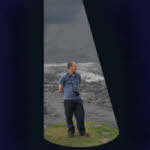Major update: 2nd May 2023
Where do dragons live today? We all have images of dragons in our minds, but they do not resemble the Komodo dragons that live on the Indonesian islands.
So when people ask, “Where do dragons live today?” they are probably thinking of those bizarre, dinosaur-like creatures that either have wings with a recognisable dragon’s head or be long and serpent-like with that same dragon’s head.
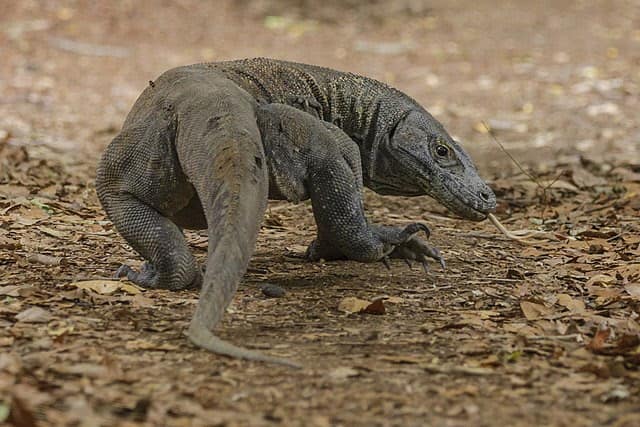
So, are flying dragons real, and are fire-breathing dragons real?
There is a lot of evidence that dragons were real in the middle ages and there are many references to dragons around the world from many different cultures.
The dragons depicted in Native American petroglyphs, Egyptian burial shrouds and Asian pottery had many common features, such as scales, wings and elongated reptilian bodies.
’10 Incredible Dragons We’d Like to Meet (or Run From)’ By: Laurie L. Dove. 2
But these disparate people couldn’t share their dragon stories in chat rooms or text dragon pictures to each other.
So how did these very different — and distant — cultures create representations of the same creature?
For many, the answer is clear:
Dragons were real, and perhaps still exist today.
Table of Contents:
1. Are dragons real creatures – based on dinosaurs?
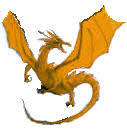
There are a lot of references to dragons in storybooks and historical records, but are dragons real?
The World Book Encyclopaedia states:
The dragons of legend are strangely like actual creatures that have lived in the past.
The World Book Encyclopaedia 3
They are much like the great reptiles which inhabited the earth long before man is supposed to have appeared on Earth.
Dragons were generally evil and destructive.
Every country had them in its mythology.”
These creatures could be based on:
- real, living dinosaurs that are described correctly, or
- they have been described with the combined features of several dinosaurs, or
- they may be based on a real dinosaur with additional exaggerations.
2. Are dragons real based on evidence in Historiae Animalium by Aristotle
Aristotle 384–322 BC has two rather tentative references which on their own would not constitute solid evidence that dragons were real and living at the time this was written.
These references are below:
The sheat-fish is destroyed in great quantities in shallow waters by the serpent called the dragon.” [p. 380]
“The dragon, when it eats fruit, swallows endive-juice; it has been seen in the act.” [p. 412]
‘Historiae Animalium’ by Aristotle 4
There is a third reference which appears to be talking about a fish known as the dragon, but this is no evidence for the existence of dragons.
Incidentally, the fish would not have been the dragon fish of today which is found in warm Indo-Pacific waters. 5
The following fishes are found near into shore—the synodon, the black bream, the merou, the gilthead, the mullet, the red mullet, the wrasse, the weaver (The name weaver is said to be wyvern , i.e. dragon*), the calli- onymus, the goby, and rock-fishes of all kinds.”
‘Historiae Animalium’ by Aristotle p. 366 (* Books own foot note).
3. Are dragons real based on evidence in Historia Animalium by Conrad Gessner
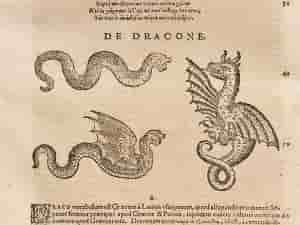
This European scientific book by Conrad Gessner 1516–1565 listed a lot of his own detailed, accurate, personal studies on animals.
He does include dragon stories that he had heard, including ones that sound plausible, but many other stories are of fantastical beasts along with Greek mythology.
I will start with the more plausible references:
When a Dragon was setting upon Orpheus, as he was occupied in hawking by his Dogs his life was saved, and the Dragon devoured.”
Conrad Gessner p.125 6
And concerning Marcus Atilius Regulus living about 307 BC to 250 BC a Roman statesman and general he wrote:
Dragons are certain great beasts, and there are none greater upon the earth.
‘Historiae Animalium’ by Conrad Gessner p.704
Neither is it to be thought incredible, that the soldiers of Attilius Regulus did kill a Dragon which was a hundred and twenty foot long…”
In talking about Panthers he does also mention a dragon:
They [panthers] use not to invade or force upon flocks of Sheep or Goats, yet wheresoever they see a Dog, they instantly kill and devour him.
‘Historiae Animalium’ by Conrad Gessner p. 452
The great Panther is a terror to the Dragon, and so soon as the Dragon seeth it, he flyeth to his cave.
The lesser Panthers or Leopards do overcome Wolves…”
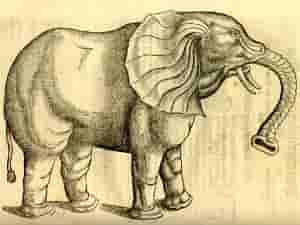
Talking about elephants, which were unknown to most readers then, he wrote that their ears and eyes were very small and out of proportion, and he compares them to more well-known creatures like bats and dragons!
I’m not sure about his saying that elephants’ ears are small!
He does include a woodcut picture of an elephant – which has got normal-sized ears.
Their head is very great, and the head of a man may easily enter into their mouth, as a finger into the mouth of a Dog, but yet their ears and eyes are not equivalent to the residue of their proportion: for they are small like the wings of a Bat or a Dragon.”
‘Historiae Animalium’ by Conrad Gessner p. 150
So, notice that he mentions a bat and a dragon as if they were well-known creatures.
Conrad Gessner talks about elephants again, this time mothers with their calves:
Sometimes they go into the water to the belly, and there calve for fear of the Dragon – the male never forsaketh her, but keepeth with her for the like fear of the Dragon, and feed and defend their young ones with singular love and constancy unto death.”
‘Historiae Animalium’ by Conrad Gessner p. 155
Again he mentions dragons as being real, living creatures.
And further on:
There is a Bird called Captilus, which is a great devourer of Kids and Lambs, and the same also is hunted by a Dragon, for when she hath filled herself with these Beasts, being wearied and idle, the Dragon doth easily set upon her and overtake her.”
‘Historiae Animalium’ by Conrad Gessner p. 197
On various occasions, the dragon is spoken of as a living creature that hunts quite large prey.
Parts of his book move further away from his scientific findings to hearsay and what others have written and include Greek mythology and fantastical creatures:
A Serpent, a Snake doth easily kill a Lion, where of Ambrosius writeth very elegantly;
‘Historiae Animalium’ by Conrad Gessner p. 362
The splendant beauty of a Lion in his long curled mane is quickly abated and allayed when the Serpent doth but lift up his head to his breast;
for such is the ordinance of God, that the Snake which runneth from a fearful heart, should without all fear kill a courageous Lion…”
For this dubious magical potion below, a real dragon was on the ingredients:
the Magicians prescribed this composition, to make a man invincible;
‘Historiae Animalium’ by Conrad Gessner p. 376
the tail and head of a Dragon, the hairs of a Lions fore-head, and the marrow of his bones…”
Here Conrad Gessner cites a lengthy tale involving a storm and a lightning strike that sets the woods alight:
The Chroniclers of the affairs of Chius do write, that in a certain Valley near to the foot of the Mountain Pelleneus, was a Valley full of straight tall trees, wherein was bred a Dragon of wonderful magnitude or greatness, whose only voice or hisling, did terrify all the Inhabitants of Chius, and therefore there was no man that durst come nigh unto him…
‘Historiae Animalium’ by Conrad Gessner p. 703
For it happened on a time that such a violent wind did arise, as did beat together all the Trees in the Wood, by which violent condition the branches fell to be on fire, and so all the Wood was burned suddenly, compassing the Dragon, whereby he had no means to escape alive, and so the trees fell down upon him and burned him.
Afterward, when the fire had made the place bare of wood, the Inhabitants might see the quantity of the Dragon, for they found many of his bones and his head, which were of such unusual greatness, as did sufficiently confirm them in their former opinion…”
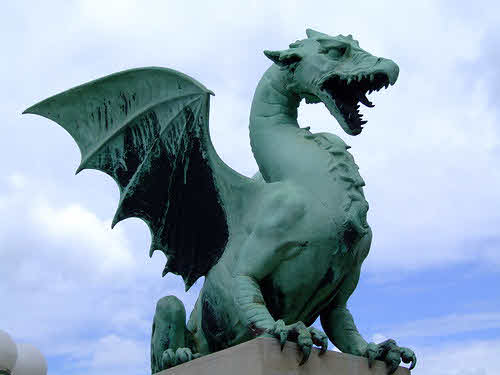
Here is a long description he copied from another source involving two types of dragons:
- Fen Dragon: Very scaly body and slow moving.
- Mountain Dragon: Some scales, a long, very flexible brown back, comb on the head, deep eyelids, very strong. Some are yellowish fiery in colour with a golden yellow beard full of bristles and saw blades along the spine.
Of the Indian Dragons there are also said to be two kinds, one of them fenny (of the fens), and living in the marshes, which are slow of pace and without combs on their heads like females:
‘Historiae Animalium’ by Conrad Gessner p. 705
the other in the Mountains, which are more sharp and great, and have combs upon their head, their backs being somewhat brown, and all their bodies less scaly then the other.
When they come down from the Mountains into the plain to hunt, they are neither afraid of marshes nor violent waters, but thrust themselves greedily into all hazards and dangers:
and because they are of longer and stronger bodies than the Dragons of the fens, they beguile them of their meat, and take away from them their prepared booties.
Some of them are of a yellowish fiery colour, having also sharp backs like saws; these also have beards, and when they set up their scales they shine like silver.
The apples of their eyes are precious stones, and as bright as fire, in which there is affirmed to be much virtue against many diseases, and therefore they bring unto the Hunters and killers of Dragons no small gain, besides the profit of their skin, and their teeth: and they are taken when they descend from the Mountains into the Valleys to hunt the Elephants, so as both of them are killed together by the Hunters.
Their members are very great, like unto the members of the greatest Swine, but their bodies are leaner, flexibly turning to every side, according to the necessity of motion;
Their snouts are very strong, resembling the greatest ravening Fishes; they have beards of a yellow golden colour, being full of bristles: and the Mountain-dragons commonly have more deep eye-lids then the Dragon of the Fens.
Their aspect is very fierce and grim, and whensoever they move upon the earth, their eyes give a sound from their eye lids, much like unto the tinkling of Brass, and sometimes they boldly venture into the Sea and take Fishes”
Here Conrad Gessner has a section about Winged dragons:
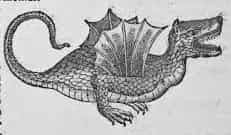
There be some Dragons which have wings and no feet, some again have both feet and wings, and some neither feet nor wings, but are only distinguished from these common sort of Serpents by the comb growing upon their heads, and the beard under their cheeks.
‘Historia Animalium’ by Conrad Gessner p. 705
Saint Augustine saith, that Dragons abide in deep Caves and hollow places of the earth, and that sometimes when they perceive moistness in the air, they come out of their holes, and beating the air with their wings, as it were with the strokes of Oars,
they forsake the earth and fly aloft; which wings of theirs are of a skinny substance, and very voluble, and spreading themselves wide, according to the quantity and largeness of the Dragons body…”
And more winged dragons:
The Inhabitants of the Kingdom of Georgia, once called Media, do say that in their Valleys there are many Dragons which have both wings and feet, and that their feet are like unto the feet of Geese.
‘Historia Animalium’ by Conrad Gessner p. 705
Besides, there are Dragons of sundry colours, for some of them are black, some red, some of anash (?) colour, some yellow, and their shape and outward appearance very beautiful, according to the verses of Nicander.”
Conrad Gessner’s writings are a mixture of very detailed accurate studies of his own, mixed with passed-down myths.
So after reading this book I am left feeling that large chunks are pure myth with fantastical creatures, whilst other sections leave me feeling convinced that there were dragons.
Is there conclusive evidence for the age of the universe?
We will look at the Cosmic Microwave Background Radiation, Modified Newtonian dynamics, Scalar–tensor–vector gravity (STVG) and Cosmic Inflation.
Does the Big Bang theory answer the question?
But could Hubble’s Law be wrong?
.
4. Are dragons real based on other evidence?
Dragons were very real for the Vikings:
The Vikings carved dragons as their figureheads on the front of their ships.
Why did they do that and why was it recognisable as a dragon all over the world?
Surely it must have been based on something real, or something that had lived at some point?
The supreme Viking ship was the longship or ‘drakkar’ often called a ‘dragon ship’ because of it’s prow which was decorated with a carving of a dragon’s head.”
Exploring the Vikings 8
The story of Beowulf is set in Scandinavia in the 6th century:
The story of Beowulf includes a fight with a fire-breathing dragon, written in a poetic style:
Had come close enough to touch its scaly Head and yet lived, as it lifted its cavernous Jaws…
The story of Beowulf 9
It could fly burning across the land, killing
And destroying with its breath…
Vomiting fire and smoke, the dragon
Burned down their homes…
Beowulf… he raised his sword
And struck at the dragon’s scaly hide.
The ancient blade broke, bit into
The monster’s skin, drew blood, but cracked
And failed him before it went deep enough, helped him
Less than needed. The dragon leaped
With pain, thrashed and beat at him, spouting
Murderous flames…
Wiglaf jumped
Behind Beowulf’s shield; his own was burned
To ashes. Then lifted…
his ancient sword, and swung it
With all his strength, smashed the gray
Blade into the beast’s head…
Then the monster charged again, vomiting
Fire, wild with pain, rushed out
Fierce and dreadful, its fear forgotten.
Watching for its chance it drove its tusks
Into Beowulf’s neck; he staggered…
Wiglaf showed courage…
By striking lower down. The sword
Sank in; his hand was burned, but shining
Blade had done its work, the dragon’s
Belching flames began to flicker…
Wikipedia describes the poem as:
This depiction indicates the growing importance and stabilisation of the modern concept of the dragon within European mythology.
Wikipedia 10
Beowulf is the first piece of English literature to present a dragon slayer.
Although many motifs common to the Beowulf dragon existed in the Scandinavian and Germanic literature, the Beowulf poet was the first to combine features and present a distinctive fire-breathing dragon.”
Even though this story is fantastical, there could be some truth behind it which describes a real encounter with a dragon.
Saint George and the Dragon
Is George slaying a dragon pure myth or is it based on some factual incident?
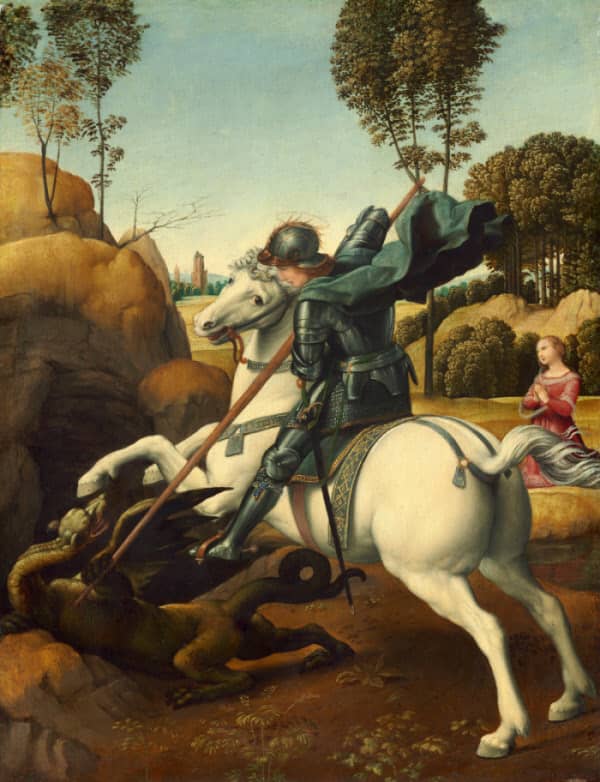
Saint George is thought to have been born into a noble Christian family in the late third century in what is now modern-day Turkey.
‘Saint George: the man, the myth, the legend’ by the Saint George’s Society. 12
As a soldier and officer in the Roman army, he refused to denounce his faith and persecute fellow Christians leading to his martyrdom in 303 AD.”
The story of Saint George slaying the dragon was brought back by the Crusaders who learned of him during the Middle Ages.
At the centre of the story was a dragon which was causing terror in a Libyan village, so they had to feed it one sheep every day unto there were none left.
They then started feeding it with the young girls of the village until George came along…
It has branched into many different stories, but the main points of the story are:
- A town was terrorised by a dragon.
- A young princess was offered to the dragon
- When George heard about this he rode into the village
- George slayed the dragon and rescued the princess 13
Obviously, this story has been exaggerated and the character of ‘George’ has been beefed up, but was this event based on a knight killing a real dragon?
Ulysses Aldrovandus the father of natural history studies:
Ulysses Aldrovandus (1522 – 1605) was an Italian naturalist and he heard that a peasant had killed a small dragon in northern Italy.
So he got the carcass of the dragon and put it in a museum.
He wrote:
The dragon was first seen on May 13, 1572, hissing like a snake.
‘The Natural History of Serpents and Dragons’ by Ulysses Aldrovandus 14
He had been hiding on the small estate of Master Petronius near Dosius in a place called Malonolta.
At 5 PM, he was caught on a public highway by a herdsman named Baptista of Camaldulus, near the hedge of a private farm, a mile from the remote city outskirts of Bologna.
Baptista was following his ox cart home when he noticed the oxen suddenly come to a stop.
He kicked them and shouted at them, but they refused to move and went down on their knees rather than move forward.
At this point, the herdsman noticed a hissing sound and was startled to see this strange little dragon ahead of him.
Trembling, he struck it on the head with his rod and killed it.”
Aldrovandus was surprised that the reptile did not run when he saw the man, but instead bravely raised its head and stood its ground.
Ulysses Aldrovandus was a man seeking to find the truth about nature and all the different animals, surely there must be some truth behind what he was researching.
Titus Flavius Josephus and flying dragons:
Titus Flavius Josephus (37 to 100AD) in ‘Antiquities of the Jews’ wrote about flying serpents which were dragons:
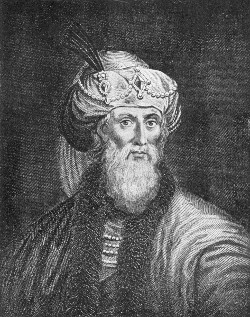
…for when the ground was difficult to be passed over, because of the multitude of serpents,
Titus Flavius Josephus Book 2, Chapter 10, Section 2
(which it produces in vast numbers, and, indeed, is singular in some of those productions,
which other countries do not breed, and yet such as are worse than others in power and mischief,
and an unusual fierceness of sight, some of which ascend out of the ground unseen,
and also fly in the air, and so come upon men at unawares, and do them a mischief,)
Moses invented a wonderful stratagem to preserve the army safe, and without hurt;
for he made baskets, like unto arks, of sedge, and filled them with ibes, and carried them along with them; which animal is the greatest enemy to serpents imaginable,
for they fly from them when they come near them;
and as they fly they are caught and devoured by them, as if it were done by the harts;
but the ibes are tame creatures, and only enemies to the serpentine kind:
but about these ibes I say no more at present, since the Greeks themselves are not unacquainted with this sort of bird.
As soon, therefore, as Moses was come to the land which was the breeder of these serpents,
he let loose the ibes, and by their means repelled the serpentine kind,
and used them for his assistants before the army came upon that ground.”
The bird named above, could it be a relative of the Northern bald ibis which is found in barren, semi-desert or rocky habitats and feeds on lizards, insects and other animals?
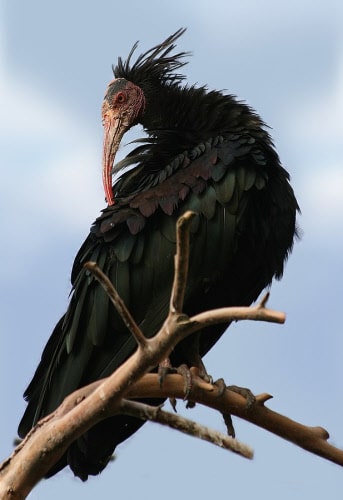
Was Josephus describing real flying dragons, or are they fantasies?
5. Are dragons real based on evidence in China and Japan?
An early Chinese scholar writes about dragons as if they are real creatures of his time:
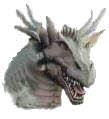

None of the animals is so wise as the dragon. His blessing power is not a false one. He can be smaller than small, bigger than big, higher than high, and lower than low.”
Chinese scholar Lu Dian (AD 1042-1102)
An even earlier scholar wrote:
The dragon’s horns resemble those of a stag, his head that of a camel, his eyes those of a demon, his neck that of a snake, his belly that of a clam, his scales those of a carp, his claws those of an eagle, his soles those of a tiger, his ears those of a cow.”
Chinese scholar Wang Fu (Han dynasty, 206 BC to AD 220)
Because a description of the Chinese dragon involves other animal features, many people believe that the image of a dragon was put together by someone back in history.
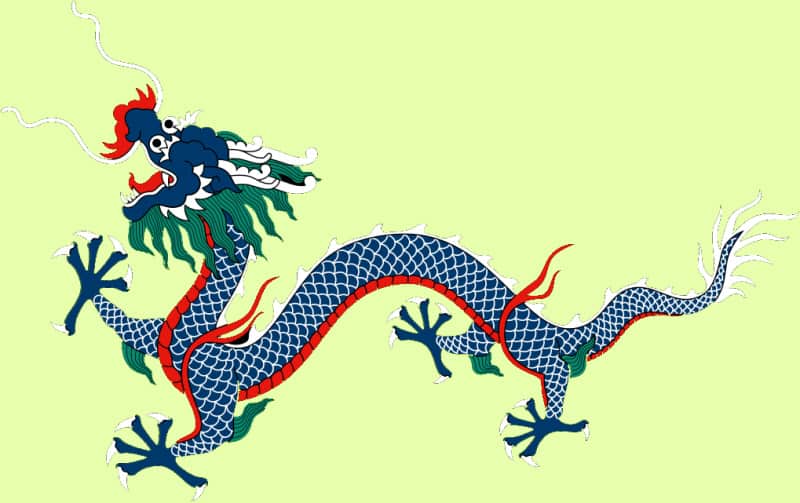
Chinese dragons typically have a long, serpentine scaly body, sharp claws, and a recognisable dragon’s head.
Some have horns, a few have wings. 17
Looking at the image above, if more natural colours were used, there is a possibility that it was based on a real creature.
The dragon represents power:
Worn into battle by Samurai warriors, the dragon was used in Japan as an emblem of masculine power. Japanese families celebrate the same spirit during the Boys’ Festival each May 5
‘Asian Dragons’ American Museum of Natural History 18
The first dinosaur fossils were probably found in China as early as the fourth century.
These fossils were referred to as dragon bones.
6. Ancient pottery and statues depict dragons
There are many examples of dragons depicted on ancient artefacts, below are just five examples:
The first is a young porcelain with a drawing of a dragon dating from about 1644:

Below is a dragon statue in Vietnam:
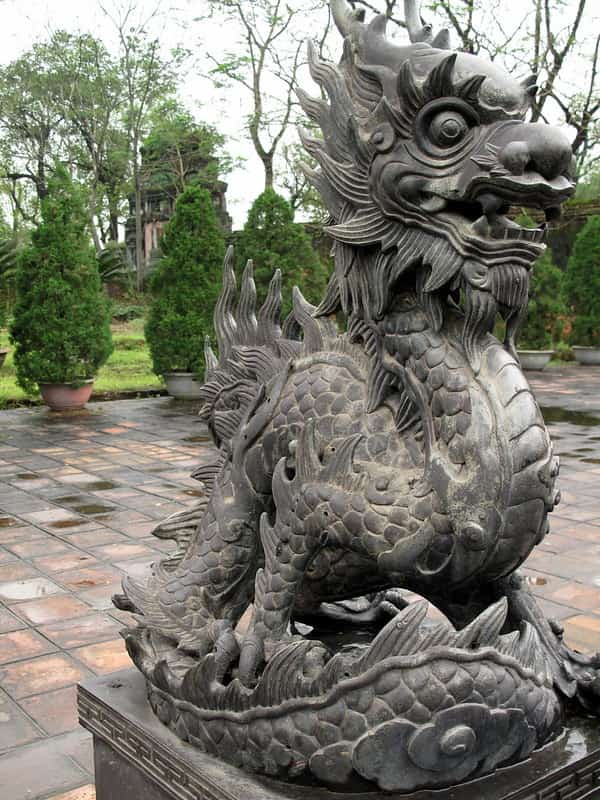
The Minoan civilisation ran from about 2000 BC to 1100 BC and here on a pottery jar winged dragons can be seen:
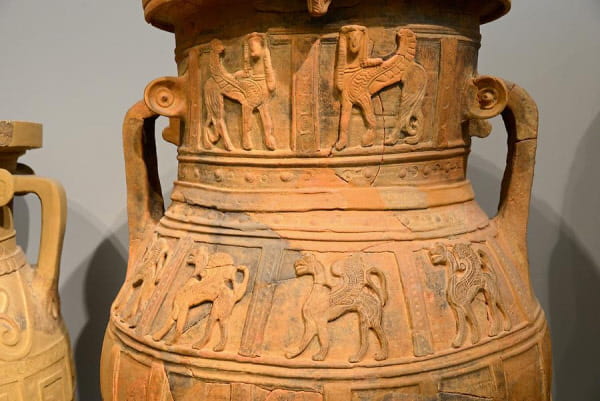
Native American rock drawings. One looks like a dinosaur or dragon:
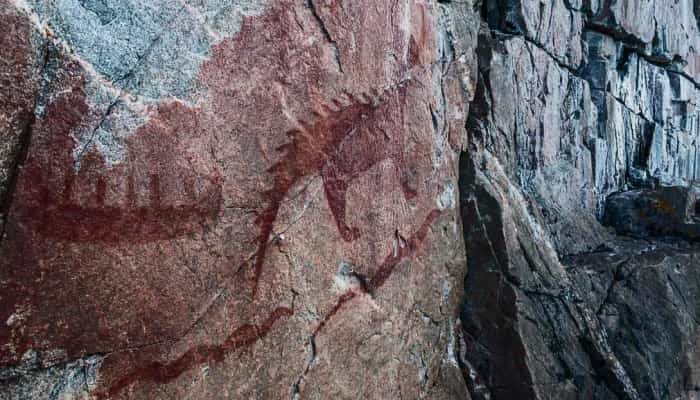
In Carlisle Cathedral in northern England, there is a marble tomb of Bishop Bell who died in 1496 and around it, on the floor, there is some medieval brass work
Even though it has been worn down by the many feet treading on it, a dinosaur or dragon can be seen:

On the head, there are some horns or big ears. There are more images of ancient dragon and dinosaur artefacts at GenesisPark 22
7. The Bible talks about dragons as fact:
The Bible does compare the Devil to a Dragon.
The dragon is obviously a symbolic image, but it must be based on a ‘dragon’ – something that is known.
Original Word: δράκων ‘drakōn’ which means “a mythical monster, a dragon;” also a large serpent, so called because of its keen power of sight, from a root ‘derk’ signifying “to see”. 23
People worshipped the dragon because he had given authority to the beast, and they also worshipped the beast and asked, ‘Who is like the beast? Who can wage war against it?’
Revelation 13:4 NIV
8. How could a dragon breathe out fire?
Many people say that it is impossible for a creature to spit out flames.
But the bombardier beetle has a fascinating mechanism for pumping out gases at a near boiling point temperature to ‘burn’ any predator:
The half-inch long beetle produces hydrogen peroxide and hydroquinones that are stored in separate reservoirs.
‘If Dragons Were Real, Could They Breathe Fire?’ By: Laurie L. Dove. 24
When the beetle becomes threatened, it releases the hydrogen peroxide and hydroquinones into a special reaction chamber where secreted enzymes quickly break down the hydrogen peroxide and release free oxygen molecules that oxidate the hydroquinones.
The result? A chemical reaction that makes enough heat to bring the entire mixture nearly to boiling.
This extremely heated mixture is then explosively sprayed on the beetle’s attacker.
The video below shows the Researcher explaining their findings:
Attention – by clicking ‘play’ your browser will load all of the Youtube Cookies.
Clicking ‘play’ means you are consenting to these Cookies.
If dragon’s had a similar, but modified system, could that enable them to breathe out flames?
Obviously, there is a lot of myth and legend about the subject of dragons, but it is worldwide and they must be based on something – creatures that were real and living, what do you think?
Many people laugh at the idea that all humanity came from the Biblical Eve.
But modern genetics is able to trace the mitochondrial DNA (mtDNA) down the female line to the one original woman from which we have all come from.
They have given her the name: ‘Mitochondrial Eve’!
But that’s not all, the Bible says we all came from the 3 child-bearing females (Noah’s son’s wives) that emerged from the Ark.
Genetics has found that the mitochondrial haplogroups are divided into three main groups!
We are repeatedly told that evolution is factually proven, but when each of the ‘facts’ is studied it shows up many errors. We look at anatomy, molecular homology, biogeography and fossils.
Even the scientific community question the Big Bang’s validity…
How does that make us feel when we are told that Genesis is a myth?
Over the years scientists completely change their theories and therefore science is in a state of flux, but we don’t know when they arrive at their final answer.
We are told that the galaxies are billions of years old, but there are a lot of ‘young stars’ and other things that don’t fit with the ‘Big Bang’ theory.
Does the huge variety of dogs ‘prove’ evolution?
The fossil bones of horses used to prove evolution, but now they don’t…
References – open in new tabs:
Thomas Fuhrmann, CC BY-SA 4.0, via Wikimedia Commons ↩
’10 Incredible Dragons We’d Like to Meet (or Run From)’ By: Laurie L. Dove. HowStuffWorks ↩
Knox, Wilson, Dragon, The World Book Encyclopaedia, vol. 5, 1973, p. 265 ↩
Historiae Animalium by Aristotle; Thompson, D’Arcy Wentworth, 1860-1948 ↩
‘Dragonfish’ Britannica ↩
Photo Credit opens in a new window: peregrinari Flickr via Compfight cc ↩
‘Exploring the Vikings’ Google Books ↩
Beowulf by Raffel, Burton; Creed, Robert Payson, 1925-2015; ↩
Saint George and the Dragon, c. 1506 by Raphael (artist) Marchigian, 1483 – 1520 Andrew W. Mellon Collection Creative Commons Zero CC0 ↩
‘Saint George: the man, the myth, the legend’ by the Saint George’s Society. 30 March 2018 ↩
‘The Legend of Saint George and the Dragon’ by Mandy Barrow. Project Britain. ↩
Aldrovandus, Ulysses, ‘The Natural History of Serpents and Dragons’, 1640, p.402. Also see ‘Frontiers of Zoology’ ↩
Richard Bartz, Munich aka Makro Freak, CC BY-SA 2.5, via Wikimedia Commons ↩
An asset of a Chinese dragon, taken from the Qing flag. User: Sodacan, CC BY-SA 4.0, via Wikimedia Commons ↩
‘Dragon in Chinese – Types, History, Symbolism, and Legends’ by Tripways. February 17, 2023 ↩
‘Asian Dragons’ American Museum of Natural History ↩
Joanbanjo, CC BY-SA 4.0, via Wikimedia Commons ↩
((‘The Lure of Agawa’ Northern Ontario Travel. Photo credit: Sheri Minardi Photography ↩
‘Concealed under Carlisle Cathedral’s carpet: dinosaurs!’ by Mark Harwood. April 2014. Creation Ministries International ↩
‘Ancient Dinosaur Depictions’ GenesisPark ↩
Vine’s Expository Dictionary of Old Testament and New Testament Words. ↩
‘If Dragons Were Real, Could They Breathe Fire?’ By: Laurie L. Dove. HowStuffWorks. ↩
